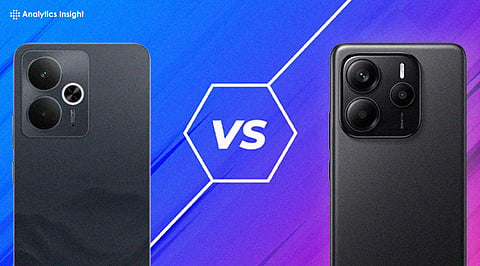

Whether it's street snaps or selfie sessions, Redmi Note 14 delivers unmatched detail, while Realme 14T keeps it stylish with smart modes and fast focus. Find out which phone is more suited for you after going through this article about the specifications of each phone.
The Realme 14T and Redmi Note 14 are two of the most recent entries in the mid-range smartphone category, offering promising hardware, competitive pricing, and enhanced imaging systems. While both devices aim to satisfy photography enthusiasts and casual users alike, differences in sensor technology, camera software, and auxiliary features contribute significantly to the overall photographic experience. This article offers a detailed comparison of both models with a focus on their camera strengths and limitations.
The following table summarizes the core camera hardware of the Realme 14T and Redmi Note 14:
Realme 14T consists of a 50MP main lens with a moderately big sensor and a 2MP monochrome lens used only for depth contribution. This translates directly into outdoor/bright lit use, where the Realme 14T captures detailed, vibrant colored images with a good dynamic range. Once light turns hard, performance comes crashing down. During low-light situations, in addition to the drawbacks of the small sensor size and absence of optical image stabilization (even with AI smoothing) introduces noticeable noise and softness are introduced.
The Redmi Note 14 has not only a higher-res 108MP main sensor, but with a larger 1/1.67” sensor size. Even more useful, this increases light absorption and detail retention, particularly in bright daylight. The resulting photos provide astonishing detail, brilliant color, and exquisite tonal range. That difference becomes even more apparent when images are enlarged or cropped. Even in low-light contexts, the sensor better manages exposure and noise, giving the Redmi Note 14 a huge advantage.
The Realme 14T’s second 2MP monochrome sensor is not as vital, mainly helping with contrast and background separation in portrait shots. That said, the absence of an ultra-wide or macro lens makes the phone feel somewhat limited in versatility across the board.
The Redmi Note 14 adds two more lenses to the mix—a 2MP depth sensor and a 2MP macro camera. The new depth sensor adds more subject-background separation, enabling dramatic portrait mode images with natural-looking bokeh to fit your style. The macro camera, though low-res, can be used for some passable close-up photography, which opens up the use for some pretty niche perspectives.
Selfie performance is a second differentiator. Selfies on the Realme 14T are handled by a 16MP front-facing camera with an f/2.4 aperture. Given enough light, the Honor 90 takes some of the best selfies I’ve shot, but in more challenging conditions, it gets overwhelmed with exposure balance and details in the background.
Outshining them in this regard, as ever, is the Redmi Note 14, which delivers 20MP selfies with brighter, crisper lighting. Skin tones look beautiful and natural, and dynamic range is improved too, making group selfies or pictures taken against backlighting shine bright.
Both smartphones are capable of recording video in crisp Full HD (1080p) at 30 or 60 fps. Realme 14T relies on electronic image stabilization (EIS) that does a decent job at stabilizing your handheld video, but will have its limitations when moving fast or panning. It all looks fine for Instagram, but it does not have a lot of filmic sheen.
Redmi Note 14 implements EIS, and it manages bumps and jostling a bit better. Videos taken with the front-facing main sensor feature improved color uniformity and more pronounced contrast. Neither device includes Optical Image Stabilization (OIS), which is usually reserved for higher-end iterations, further limiting their overall performance when on-the-go or in low-light videography.
Realme 14T packs a host of creative modes: Night Mode, Portrait Mode, Pro Mode, Street Mode, and Dual-View Video, allowing for simultaneous recording with front and back cameras. The Street Mode is specifically designed for quick, action or street photography with preset filters and quick shutter speeds.
Redmi Note 14 uses the same modes but takes them a step further with AI-based scene detection and auto optimization. Portrait and Night modes are greatly improved by real-time processing, adjusting attributes like exposure, contrast, and saturation in real-time to best suit the scene. These refinements lead to more robust performance concerning changing illumination.
Image processing is crucial for smartphones, especially in mid-range devices where raw hardware is sometimes limited. Realme’s camera app is functional and relatively fast, with real-time previews and minimal lag. However, post-processing sometimes leads to slightly over-sharpened edges or minor color oversaturation.
Xiaomi’s Redmi Note 14 benefits from a more mature image processing pipeline, balancing sharpness and noise reduction more effectively. The processing tends to produce lifelike colors, smoother skin tones, and better HDR (High Dynamic Range) effects, especially in high-contrast scenes.
Realme 14T performs reliably in most general photography scenarios. It offers speed and simplicity, making it suitable for users who prioritize ease of use and quick social media sharing. However, enthusiasts looking for depth and versatility may find its dual-lens system limiting.
Redmi Note 14, while slightly more complex in interface due to its AI enhancements and feature set, offers a more robust experience overall. Performance remains consistent across environments, and the added macro and depth lenses provide expanded creative possibilities.
Both Realme 14T and Redmi Note 14 are strong contenders in the mid-range smartphone space, but when focusing solely on camera performance, the Redmi Note 14 emerges as the more capable device. With a higher-resolution 108MP main sensor, enhanced selfie capabilities, more comprehensive lens setup, and superior image processing, the Redmi Note 14 offers better value for those prioritizing photography.
The Realme 14T holds its ground with dependable performance, attractive features like Dual-View video, and user-friendly modes, making it a solid option for casual users. However, in terms of imaging power, sensor flexibility, and low-light performance, Redmi Note 14 leads the competition in the mid-range camera battle.
